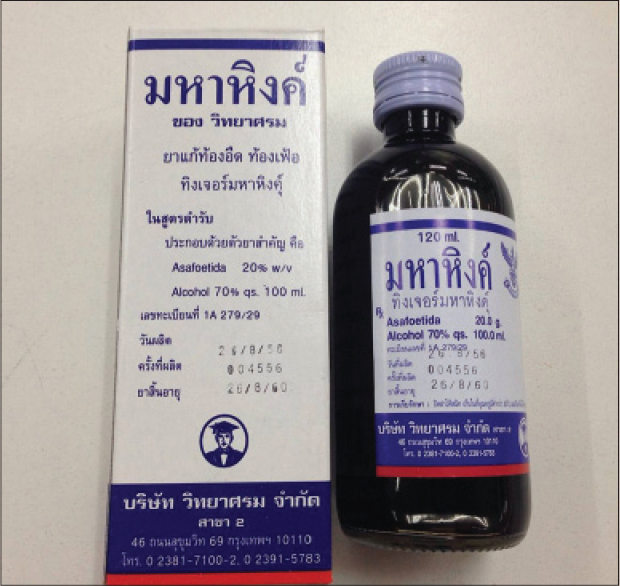Translate this page into:
Localized contact dermatitis from Ferula assa-foetida oleo-gum-resin essential oil, a traditional topical preparation for stomach ache and flatulence
Correspondence Address:
Therdpong Tempark
Department of Pediatrics, 11th Floor, Sor Kor Building, Rama IV Road, Pathumwan, Bangkok 10330
Thailand
| How to cite this article: Tempark T, Chatproedprai S, Wananukul S. Localized contact dermatitis from Ferula assa-foetida oleo-gum-resin essential oil, a traditional topical preparation for stomach ache and flatulence. Indian J Dermatol Venereol Leprol 2016;82:467 |
Sir,
The topical use of Ferula assa-foetida oleo-gum-resin essential oil, a traditional phyto-medicine believed to be effective in gastrointestinal disorders like flatulence and colic in infants has been associated with localized eczematous lesions, particularly in the abdominal region. Localized contact dermatitis could occur from either the alcohol and/or the chemical component, which should be used with caution in infants.
Thirty two healthy infants of the age group 1–6 months were brought with localized eczematous lesions on the abdominal area after contact with the essential oil. The indigenous preparation was being applied on the affected parts of the abdomen over a period of time ranging from a couple of days to weeks, as a part of traditional treatment. No eczematous lesions were found on other parts of the body or on family members who applied the topical essential oil. Only four of the thirty two patients had underlying mild atopic dermatitis.
On examination, the patients had a variety of lesions including erythematous papules, macules, annular or bizarre-shaped plaques with associated localized xerosis of the skin. Perifollicular accentuation and excoriation was also seen in some areas on the abdomen [Figure - 1]. The parents or caregivers were asked to stop using the topical preparation and were prescribed bland emollients on the affected area. The lesions resolved completely in all the cases.
 |
| Figure 1: Cases of localized eczema on the abdomen in young infants |
Ferula assa-foetida oleo-gum-resin essential oil has been widely used in many countries such as Iran, India, China and Thailand as a traditional topical treatment for stomach ache and flatulence in infants. Besides its sulfurous odor and bitter taste from terpenes and oxygenated derivatives (aromatic acid, esters and phenolic compound), this over-the-counter topical preparation also contains 70% alcohol as astringent and other chemical agents (ferulic acid, sesquiterpene, sulfur-containing compounds and other volatile terpenoids) [Figure - 2]. The assa-foetida preparation is composed of many mixtures consisting primarily of resins (40–64%), gums (25%) and essential oils (10–17%).[1] Theoretically, the complexity of this composition can result in both irritant contact dermatitis due to the high alcohol content and allergic contact dermatitis to the oleo-gum resin part, a common allergic sensitizer.[2]
 |
| Figure 2: Traditional topical medicine, Ferula assa-foetida oleo-gum-resin essential oil |
The prevailing common belief that the application of this herbal preparation after feeding the infant is beneficial in flatulence, stomach ache and related ailments makes the pattern of application very irregular and therefore, it is difficult to ascertain the interval between the application and the onset of rash in all cases. Some parents discontinue the use of this topical agent at the development of the rash, only to find a recurrence of the rash within a couple of days of re-challenge. Consequently, the differentiation between allergic and irritant contact dermatitis remains uncertain and further studies should be performed to confirm the diagnosis.
There were limitations to do patch testing in our series to prove the hypothesis. Our series of localized contact dermatitis cases occurred in very young infants; parents were often not comfortable with procedures and had concerns whether the contact sensitizer allergens could induce allergic contact dermatitis in the future. In addition, the reduced integrity of the skin barrier in an infant is a contributing factor in the causation of this dermatitis, especially in infants with atopic dermatitis and skin barrier dysfunction that allows potential allergens to penetrate into the skin. But the most recent studies reveal no difference in terms of sensitization and occurrence of allergic contact dermatitis in the atopic dermatitis and non-atopic dermatitis groups.[3],[4] Furthermore, the reliability of patch testing in infants or very young children and the appropriate age group to start patch testing still remain uncertain.[3] Ideally, young children should undergo the patch test with only selective allergens to identify the highly positive and relevant reactions alone.[2]
Recent studies have revealed a rise in the incidence of allergic contact dermatitis in children due to the more frequent exposure to allergens from a younger age.[5] Both the sensitivity of contact allergens and the frequency of positive patch test reactions increase with age due to additional environmental exposure, particularly from 0 to 3 years which showed the highest sensitization rate in children.[4]
We were unable to find any previous case series or reports of contact dermatitis from F. assa-foetida oleo-gum-resin essential oil. Even though we could not perform patch testing due to multiple limitations, the patients were followed up after stopping the topical use. All patients recovered without further recurrence.
Financial support and sponsorship
Nil.
Conflicts of interest
There are no conflicts of interest.
| 1. |
Iranshahy M, Iranshahi M. Traditional uses, phytochemistry and pharmacology of asafoetida (Ferula assa-foetida oleo-gum-resin) – A review. J Ethnopharmacol 2011;134:1-10.
[Google Scholar]
|
| 2. |
Jacob S. Contact dermatitis. In: Schachner LA, Hansen RC, editors. Pediatric Dermatology. 4th ed. Philadelphia: Mosby, Elsevier; 2011. p. 887-97.
[Google Scholar]
|
| 3. |
Simonsen AB, Deleuran M, Johansen JD, Sommerlund M. Contact allergy and allergic contact dermatitis in children – A review of current data. Contact Dermatitis 2011;65:254-65.
[Google Scholar]
|
| 4. |
Seidenari S, Giusti F, Pepe P, Mantovani L. Contact sensitization in 1094 children undergoing patch testing over a 7-year period. Pediatr Dermatol 2005;22:1-5.
[Google Scholar]
|
| 5. |
Militello G, Jacob SE, Crawford GH. Allergic contact dermatitis in children. Curr Opin Pediatr 2006;18:385-90.
[Google Scholar]
|
Fulltext Views
2,705
PDF downloads
2,152





